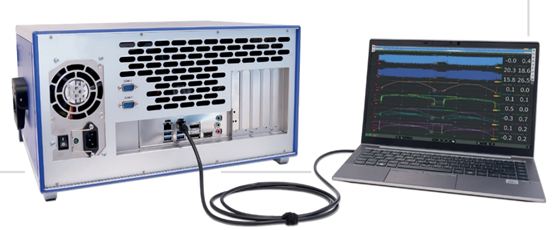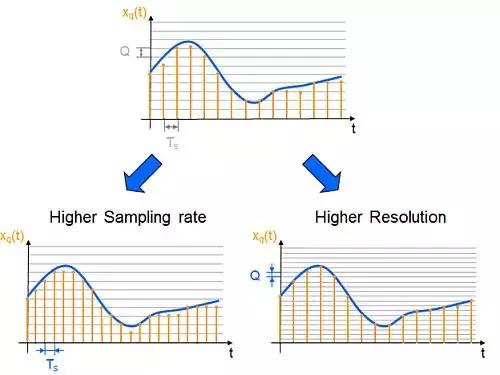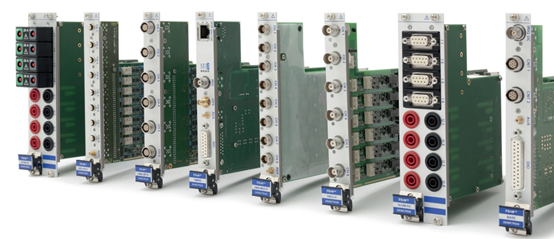In modern industrial and scientific research fields, Data Acquisition Systems (DAQ) play a crucial role in capturing data from the physical world for analysis and processing. To ensure the performance of a data acquisition system meets the requirements of specific applications, understanding its core parameters is essential. This article will focus on nine key parameters—sampling rate, bit depth, input range, accuracy, isolation voltage, channel count, filter characteristics, total harmonic distortion, and signal-to-noise ratio—detailing their functions.

Figure 1 DAQ System Used with a Computer
Sampling Rate: The sampling rate determines the frequency range of signals that a data acquisition system can capture. According to the Nyquist Sampling Theorem, the sampling rate must be at least twice the highest frequency component of the signal to accurately reconstruct the original signal. A higher sampling rate allows capturing higher-frequency signals, improves time resolution, and ensures accurate capture of signal details. This is particularly important for measuring rapidly changing signals or transient events. Furthermore, the sampling rate also affects data storage and processing requirements; a balance must be struck between measurement accuracy and system resources to avoid data redundancy and system overload, thereby improving efficiency.
Bit Depth: Bit depth refers to the resolution of the analog-to-digital converter when converting analog signals to digital signals, indicating the smallest voltage change the acquisition system can distinguish. A higher bit depth means smaller quantization error, enabling more precise capture of minute signal variations and enhancing measurement accuracy. This is highly significant for applications demanding high precision and detail, such as precision measurement and control systems. Higher bit depth also expands the signal's dynamic range, allowing the system to measure both strong and weak signals simultaneously without distortion. However, higher bit depth places greater demands on the system's noise level and data processing capabilities, requiring consideration of the system's overall performance.
Input Range: The input range determines the voltage amplitude of signals that the data acquisition system can measure. A wide input range makes the system suitable for various voltage level measurement needs, from low-voltage sensor signals to high-voltage power system monitoring. Flexible input ranges help improve the system's adaptability to meet the requirements of different application scenarios.

Figure 2 Impact of Sampling Accuracy on Signal Acquisition
Accuracy: Accuracy reflects the deviation between the measured value and the true value and is a critical indicator for assessing the reliability of a data acquisition system. High accuracy ensures data credibility and is vital for applications requiring precise measurements, such as metrology, quality control, and scientific research. Accuracy is influenced by various factors, including hardware design, calibration, and environmental conditions.
Isolation Voltage: Isolation voltage refers to the electrical isolation capability between the input channels of the data acquisition system and other circuits or ground. High isolation voltage provides safe measurement capability for high-voltage signals, preventing damage to equipment and injury to personnel. Additionally, electrical isolation helps reduce noise caused by ground loops and common-mode voltages, enhancing the system's anti-interference capability and signal quality.
Channel Count: The channel count determines the number of independent signals a data acquisition system can measure simultaneously. A higher channel count allows monitoring multiple signal sources concurrently, improving test efficiency and meeting the needs of complex testing scenarios. For example, in power system testing, it may be necessary to simultaneously measure voltage and current signals from multiple lines.

Figure 3 Multi-Channel DAQ Card
Filter Characteristics: Filters are used to eliminate high-frequency noise and interference from signals, improving signal quality. Programmable filters allow users to select appropriate filter types and cutoff frequencies based on application requirements. Bessel filters offer linear phase response, suitable for applications requiring preservation of waveform shape; Butterworth filters provide a flat magnitude response, suitable for general signal filtering. Delay compensation functionality can correct signal delays introduced by filters, ensuring timing accuracy.
Total Harmonic Distortion and Signal-to-Noise Ratio: Total Harmonic Distortion (THD) and Signal-to-Noise Ratio (SNR) are important metrics for evaluating the signal fidelity of a data acquisition system. Low THD indicates minimal signal distortion by the system, enabling accurate reproduction of the original signal. High SNR indicates that the useful signal components dominate, with minimal noise impact. These parameters directly affect measurement accuracy and quality and are particularly important for demanding measurement tasks such as audio testing, vibration analysis, and precision electronic measurements.
Understanding and correctly selecting the core parameters of a data acquisition system is crucial for ensuring its performance meets the needs of specific applications. Sampling rate and bit depth determine the system's temporal and amplitude resolution; input range and isolation voltage ensure the system's safety and applicability; accuracy and signal fidelity metrics (like THD and SNR) influence measurement reliability; channel count and filter characteristics provide system flexibility and adaptability. Therefore, when selecting or designing a data acquisition system, these parameters should be comprehensively considered based on the specific application requirements to choose the most suitable configuration. Only in this way can the performance of the data acquisition system be fully utilized to achieve efficient, accurate, and reliable data acquisition and analysis.
Doewe Technologies is consistently committed to delivering innovative, unique, and reliable product solutions in the field of data acquisition. We deeply understand that these elements are the cornerstone for enterprises to establish themselves in market competition. Precisely for this reason, our inspiration for innovation stems from the real application needs of customers, not merely to showcase flashy but impractical product features. Through continuous optimization and enhancement of data acquisition solutions, Doewe Technologies empowers partners to move towards a high-precision future. Welcome to choose Doewe Technologies to jointly open a new chapter in data acquisition.